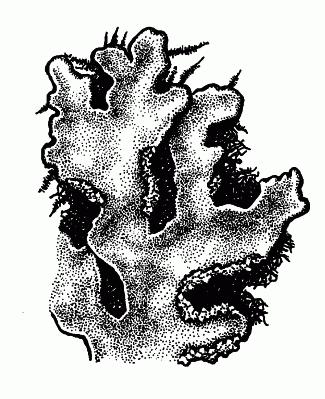Physconia enteroxantha (Nyl.) Poelt
Gilded frost
Physciaceae
Introduction to the Lichens
Gilded frost
Physciaceae
Introduction to the Lichens
Map
Distribution of Physconia enteroxantha unavailable
Species Information
General:
Common Name: The Frost Lichens. Alludes to the characteristic presence of white pruina over the upper surface of the species.
Medium stratified foliose lichens, corticate above and below (ours), sorediate or isidiate or not, lobes appressed to loosely attached, elongate, averaging to 0.5–2 (–3) mm wide, thin. Upper surface brownish, except often heavily white-pruinose, K-, dull to somewhat shiny. Lower surface pale to more often blackish, dull, bearing numerous squarrose rhizines. Medulla white or occasionally pale yellow. Photobiont green.
Apothecia located over upper surface, disc white-pruinose; spores 2-celled, ellipsoid, brown, 8 per ascus.
Over calcium-rich substrates, including rock, soil, duff, bark and bone.
Notes: Seven species of Physconia are reported for North America and five of these are known to occur in B.C. Chemistry is of little taxonomic importance in this genus, with the exception of the K+ yellow medullary reaction of P. enteroxantha. See, however, the notes under that species. The species currently assigned to Physconia were formerly treated within Physcia. The genus is under taxonomic review by T. Esslinger; this treatment is provisional.
Species description:
Thallus bearing soredia and/or isidia (check lobe tips) AND
Soredia/isidia mostly confined to marginal soredia, these not reaching lobe tips; lobe tips more or less appressed; lower surface darkening abruptly toward thallus centre AND
Medulla pale yellowish, K+ yellow; upper surface generally strongly pruinose, dull
Comments:
The K+ yellow reaction is spotty and difficult to demonstrate in a small percentage of the specimens examined. Such material would key out as P. detersa, though the upper surface of that species is usually rather shiny and not heavily white-pruinose as in P. enteroxantha. Physconia detersa also appears to have a strictly boreal distribution in B.C.
Reactions:
Medulla K+ yellow.
Contents:
One unidentified lichen substance.
Source: Lichens of British Columbia
Illustration

If more than one illustration is available for a species (e.g., separate illustrations were provided for two subspecies) then links to the separate images will be provided below. Note that individual subspecies or varietal illustrations are not always available.
Illustration By: Trevor Goward
Habitat and Range
Habitat: Frequent over deciduous trees, shrubs and (mossy) base-rich rocks in open maritime and intermontane sites at lower elevationsWorld Distribution: probably incompletely circumpolar, N to AK, S to CA.
Source: Lichens of British Columbia